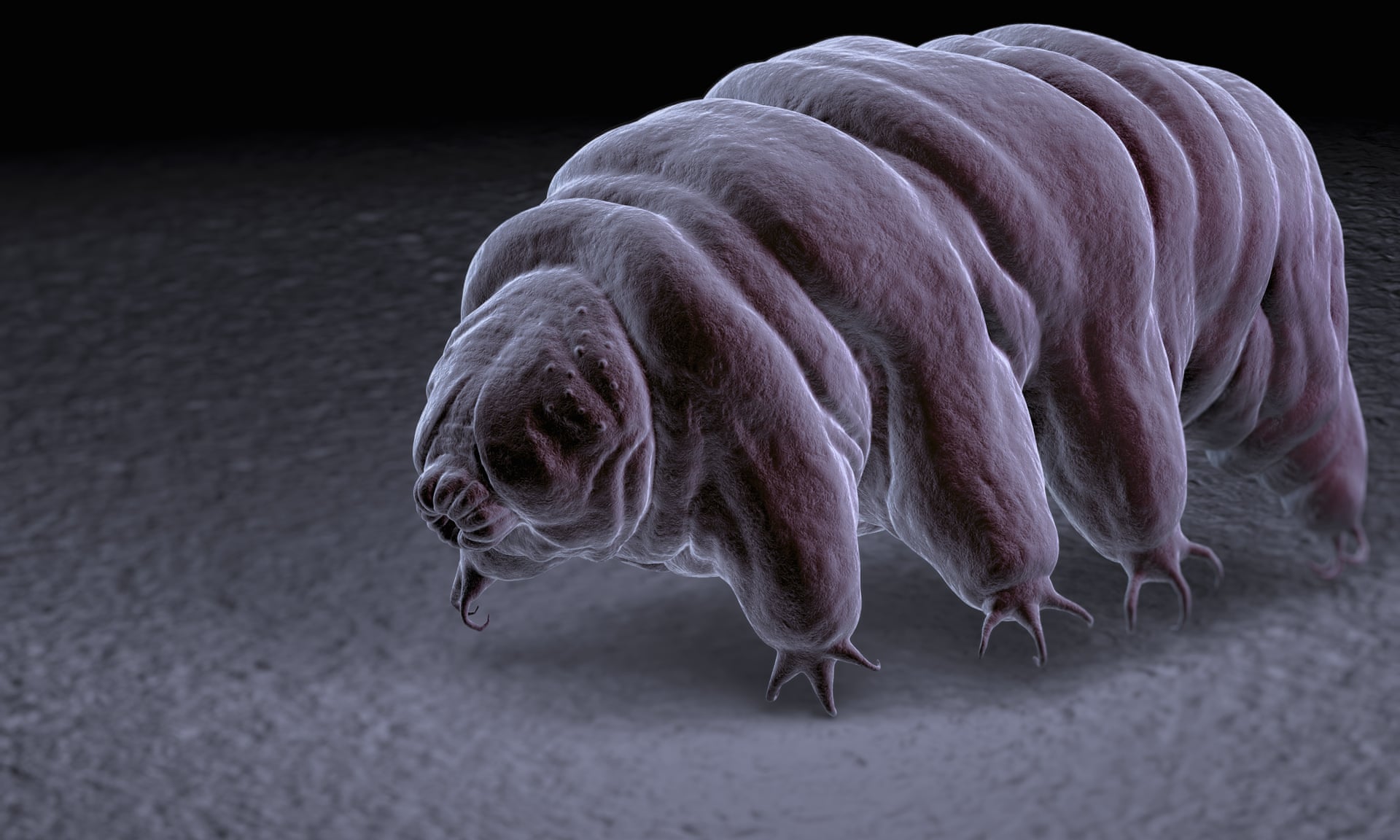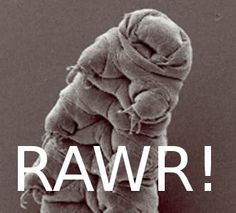Article from the Guardian:

The odds of finding life on the moon have suddenly rocketed skywards. But rather than elusive alien moonlings, the beings in question came from Earth and were spilled across the landscape when a spacecraft crashed into the surface.
The Israeli Beresheet probe was meant to be the first private lander to touch down on the moon. And all was going smoothly until mission controllers lost contact in April as the robotic craft made its way down. Beyond all the technology that was lost in the crash, Beresheet had an unusual cargo: a few thousand tiny tardigrades, the toughest animals on Earth.
Now, the organisation behind the tardigrades’ trip, the US-based Arch Mission Foundation – whose goal is to find a backup for Earth – has said the organisms may well have shrugged off the collision. “Our payload may be the only surviving thing from that mission,” Nova Spivack, the organisation’s founder, told Wired magazine.
Tardigrades have fascinated scientists since their discovery in the 18th century by the German zoologist and pastor Johann August Ephraim Goeze. The millimetre-long animals, sometimes known as water bears or moss piglets after their favoured environment and food, resemble cheerful eight-legged maggots wearing distinctly sphincter-like faces.
But it is not their appearance that has made their name. Tardigrades are considered the hardiest animals on Earth. They have been found on mountain tops, in scorching deserts, and lurking in subglacial lakes in Antarctica. In his book The Hidden Powers of Animals, Dr Karl Shuker claimed the beasts survived being frozen in liquid helium and being boiled at 149C.
The tardigrade’s secret is the ability to shrivel into a seed-like pod, expelling nearly all of its water and slashing its metabolism. In this “tun” state, the animals can hunker down and survive conditions that would normally be swiftly fatal. In 2007, scientists discovered that inactive tardigrades are so tough they can survive the harsh radiation and frigid vacuum of space travel.
And so it came to be that there is life on the moon, probably. Lukasz Kaczmarek, a tardigrade expert and astrobiologist at the Adam Mickiewicz University in Poznań, said the animals may well have survived the crash landing. “Tardigrades can survive pressures that are comparable to those created when asteroids strike Earth, so a small crash like this is nothing to them,” he said. The animals could potentially survive on the moon for years, he added.
Dehydrated tardigrades have been revived after years in an inactive state by plunging them into water. Once rehydrated, the animals become active again and feed and reproduce as normal. There is little chance of that happening to those that are lost in space, however. “They cannot colonise the moon because there is no atmosphere and no liquid water,” Kaczmarek said. “But it could be possible to bring them back to Earth and then add the water. They should resurrect.”
Kaczmarek is exploring whether the ageing process itself grinds to a halt in dormant tardigrades, through what he calls a Sleeping Beauty model. He said it appears that a tardigrade that enters a tun state at one month old emerges with the same biological age when it is revived a decade later. “It is really amazing,” he said. “It may be that we can use this in the future if we plan missions to different planets, because we will need to be young when we get there.”
Philippe Reekie, an astrobiologist and PhD student at the University of Edinburgh, agreed that there was no reason to think dehydrated tardigrades would not survive on the moon. “I would imagine they would survive for some time,” he said. “The main problem with the moon is the vacuum and the high radiation, but tardigrades are proven to survive those conditions.”
But he cautioned that if the tardigrades were in an active state on impact, they may well have met their end. “In their normal state, you can kill them quite easily,” he said. “We accidentally killed loads by accident because we subjected them to the extreme cold too fast.”
Because the moon is considered lifeless, Nasa’s office of planetary protection does not frown on missions that spill Earthly organisms on its surface. After all, the Apollo astronauts left behind their own microbes in the 96 bags of human waste that await some future cleaner on the moon. Had the spacecraft spilled its living cargo on Mars, the story might be very different.
So how do you feel about the human race helping this alien invasion? Do you support the Tardigrades lunar empire or are you against it? Has the War of the Worlds finally started?


The odds of finding life on the moon have suddenly rocketed skywards. But rather than elusive alien moonlings, the beings in question came from Earth and were spilled across the landscape when a spacecraft crashed into the surface.
The Israeli Beresheet probe was meant to be the first private lander to touch down on the moon. And all was going smoothly until mission controllers lost contact in April as the robotic craft made its way down. Beyond all the technology that was lost in the crash, Beresheet had an unusual cargo: a few thousand tiny tardigrades, the toughest animals on Earth.
Now, the organisation behind the tardigrades’ trip, the US-based Arch Mission Foundation – whose goal is to find a backup for Earth – has said the organisms may well have shrugged off the collision. “Our payload may be the only surviving thing from that mission,” Nova Spivack, the organisation’s founder, told Wired magazine.
Tardigrades have fascinated scientists since their discovery in the 18th century by the German zoologist and pastor Johann August Ephraim Goeze. The millimetre-long animals, sometimes known as water bears or moss piglets after their favoured environment and food, resemble cheerful eight-legged maggots wearing distinctly sphincter-like faces.
But it is not their appearance that has made their name. Tardigrades are considered the hardiest animals on Earth. They have been found on mountain tops, in scorching deserts, and lurking in subglacial lakes in Antarctica. In his book The Hidden Powers of Animals, Dr Karl Shuker claimed the beasts survived being frozen in liquid helium and being boiled at 149C.
The tardigrade’s secret is the ability to shrivel into a seed-like pod, expelling nearly all of its water and slashing its metabolism. In this “tun” state, the animals can hunker down and survive conditions that would normally be swiftly fatal. In 2007, scientists discovered that inactive tardigrades are so tough they can survive the harsh radiation and frigid vacuum of space travel.
And so it came to be that there is life on the moon, probably. Lukasz Kaczmarek, a tardigrade expert and astrobiologist at the Adam Mickiewicz University in Poznań, said the animals may well have survived the crash landing. “Tardigrades can survive pressures that are comparable to those created when asteroids strike Earth, so a small crash like this is nothing to them,” he said. The animals could potentially survive on the moon for years, he added.
Dehydrated tardigrades have been revived after years in an inactive state by plunging them into water. Once rehydrated, the animals become active again and feed and reproduce as normal. There is little chance of that happening to those that are lost in space, however. “They cannot colonise the moon because there is no atmosphere and no liquid water,” Kaczmarek said. “But it could be possible to bring them back to Earth and then add the water. They should resurrect.”
Kaczmarek is exploring whether the ageing process itself grinds to a halt in dormant tardigrades, through what he calls a Sleeping Beauty model. He said it appears that a tardigrade that enters a tun state at one month old emerges with the same biological age when it is revived a decade later. “It is really amazing,” he said. “It may be that we can use this in the future if we plan missions to different planets, because we will need to be young when we get there.”
Philippe Reekie, an astrobiologist and PhD student at the University of Edinburgh, agreed that there was no reason to think dehydrated tardigrades would not survive on the moon. “I would imagine they would survive for some time,” he said. “The main problem with the moon is the vacuum and the high radiation, but tardigrades are proven to survive those conditions.”
But he cautioned that if the tardigrades were in an active state on impact, they may well have met their end. “In their normal state, you can kill them quite easily,” he said. “We accidentally killed loads by accident because we subjected them to the extreme cold too fast.”
Because the moon is considered lifeless, Nasa’s office of planetary protection does not frown on missions that spill Earthly organisms on its surface. After all, the Apollo astronauts left behind their own microbes in the 96 bags of human waste that await some future cleaner on the moon. Had the spacecraft spilled its living cargo on Mars, the story might be very different.
So how do you feel about the human race helping this alien invasion? Do you support the Tardigrades lunar empire or are you against it? Has the War of the Worlds finally started?

